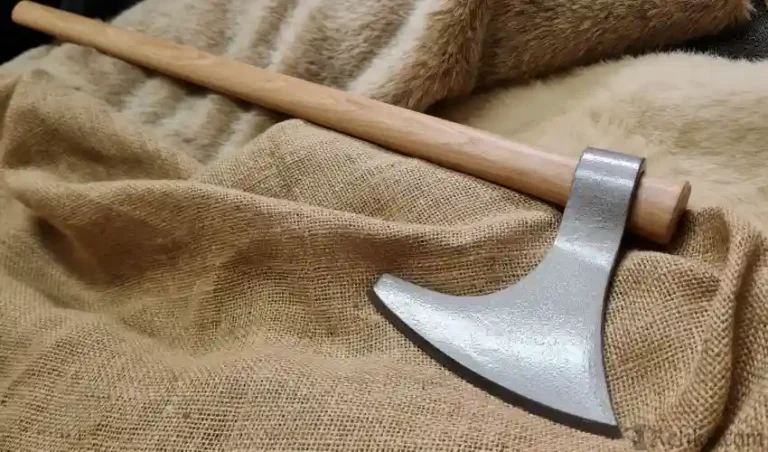Viking culture continues to fascinate people across the world with its tales of exploration, conquest, and craftsmanship. One iconic symbol of the Norse warriors is their axe — a weapon as practical as it was fearsome. While many know the Viking axe as a powerful tool of war, there’s much more to uncover about its history and significance. Here are seven lesser-known facts about Viking axes that reveal their complexity and importance.
- A Versatile Tool Beyond Battle
Viking axes were not just weapons; they were multipurpose tools essential to daily life. The Scandinavian people used these axes for various practical purposes, including chopping wood, building homes, crafting ships, and hunting. This multifunctionality made the axe more valuable than swords, which were expensive and considered luxury items. A Viking’s axe was, therefore, a representation of both survival and warfare, highlighting the practicality that defined their lifestyle.
- Variety of Designs for Different Purposes
Unlike the one-size-fits-all image that is often associated with Viking axes, they came in multiple designs, each serving distinct purposes. The bearded axe, or Skeggöx, is one such example, named for its extended lower part that resembled a beard. This design allowed warriors to hook shields or disarm their opponents in battle. For everyday tasks, simpler hatchets were used, which had shorter handles and a balanced blade perfect for precise work. The wide range of Viking axe designs showcased the adaptability and ingenuity of Norse craftsmanship.
- Artistry and Customization
Viking axes were not only functional; they were also works of art. Warriors often personalized their axes with intricate carvings and decorations, showcasing both skill and status. Designs often included symbols such as runes, animals, or Norse gods to invoke protection and power. These customizations made each axe unique, signifying the warrior’s heritage, beliefs, and personal stories. The artistry of Viking axes provides insight into their cultural significance as symbols of identity and strength.
- Axes Were More Common Than Swords
Due to their cost and the scarcity of materials needed to forge them, swords were reserved for the elite class and high-ranking warriors. Axes, on the other hand, were relatively easy to produce and accessible to everyone. Most Vikings, from farmers to soldiers, owned at least one axe. The egalitarian nature of the axe symbolized the rugged self-reliance of Viking society. Even the most basic axes were formidable weapons in the hands of an experienced warrior, proving that wealth was not the only determinant of power.
- The Symbolism of the Axe in Norse Mythology
In Norse mythology, axes held symbolic significance and were sometimes associated with gods and mythical heroes. For instance, the god Skadi, who was associated with winter and the hunt, was depicted wielding an axe. The weapon represented not just physical strength but also courage, protection, and determination. The association of axes with divine beings reinforced the Vikings’ belief that wielding such weapons imbued them with supernatural protection in battle.
- Tactical Techniques in Battle
The way Viking warriors used their axes was highly strategic. Contrary to popular depictions of wild, uncalculated swings, Vikings employed sophisticated fighting techniques. The bearded axe allowed for swift, precise strikes as well as defensive maneuvers like catching enemy blades. They could also use the hooked part to pull shields away from foes or trip them in combat. Some axes were designed with broader, heavier blades meant for devastating, cleaving blows, while lighter ones were ideal for rapid attacks and defense. This tactical use of axes demonstrated the Vikings’ skill as warriors who combined brute force with strategic acumen.
- Axe Craftsmanship: More Than Just Forging Metal
Creating a Viking axe was a labor-intensive process that required more than simply forging metal. Skilled blacksmiths would carefully heat and shape iron or steel, sometimes welding a harder steel edge onto an iron head for added sharpness and durability. The haft, or handle, was equally important and typically made from tough woods like ash or oak. The length of the handle varied, with shorter handles being more suitable for throwing and longer ones for greater leverage in combat. Blacksmiths took pride in balancing the weight and design of the axe to create a reliable and lethal weapon.
Conclusion
Viking axes are more than historical artifacts; they are testaments to the Norse people’s resourcefulness, artistry, and warrior spirit. Beyond the simplicity suggested by their outward appearance, these tools held cultural, practical, and symbolic significance. They reflect a society that valued craftsmanship and adaptability, attributes that helped Vikings survive and thrive in harsh environments. Whether used for cutting down trees or defeating foes on the battlefield, Viking axes were central to life in the Viking Age, embodying both utility and power.
